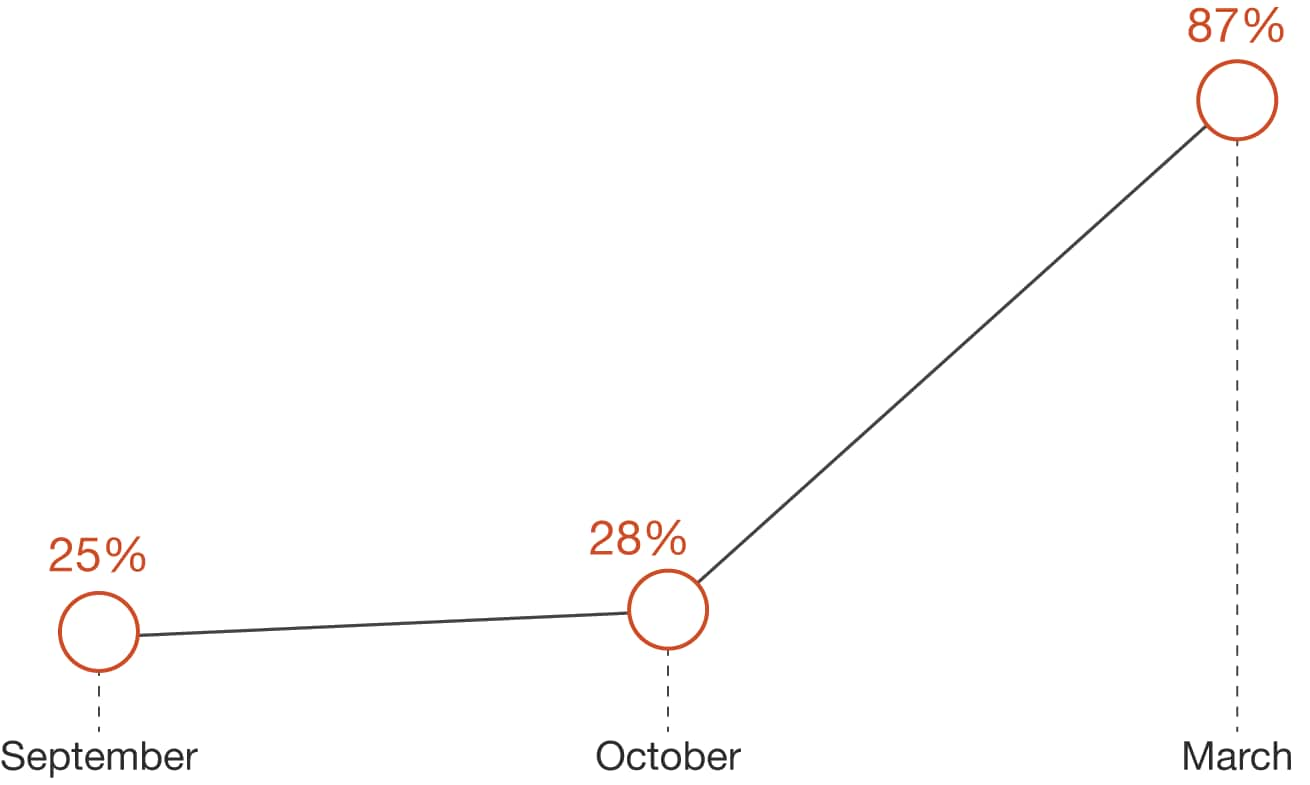

Origin Compliance
Automate and help streamline origin calculation, supplier solicitation, trade compliance and procurement planning with our customizable platform.
Our first Pulse Survey of 2021 finds confidence among US business leaders surging amid expectations of a strong US economic recovery. But that positive outlook is clouded by concerns around social factors. While many companies have found ways to prosper without going back to pre-COVID-19 patterns, they remain troubled by the lingering effects of the pandemic on the workforce and their communities. For example, 29% told us that resuming business travel is very important, well below the 52% who believe their prospects are intertwined with the pace of schools reopening. Less than a third of executives are optimistic that the country can close the social and economic gaps that became more apparent last year.
Eighty-three percent of all US business leaders are expecting to increase revenues this year. That’s a significant jump over last fall when only a quarter of finance leaders were expecting growth. Part of that optimism comes from the $1.9 trillion in COVID-19 relief money that’s flowing into the economy — just as rapid vaccine rollout is easing restrictions on economic activities. In our past Pulse surveys, business leaders have consistently, and almost unanimously, sought a strong federal government response to the COVID-19 crisis. Today, 71% percent express satisfaction with the US pandemic response.
With an acute awareness of their own role in rebooting work and lives in 2021 after a devastating year, many business leaders are taking concrete action. Topping the business agenda is supporting and strengthening a pandemic-weary workforce and growing trust among all stakeholders. We conducted this survey from March 8 to March 12 and fielded responses from 732 senior executives in C-suite and corporate board director roles. Senior executives shared what’s most important for their companies to thrive in a post-pandemic economy and their strategies for success in 2021.
Bring data and critical insights to policymakers: The outlook on the US policy and regulatory environment is mixed, with 42% viewing it favorably and 37% expressing pessimism. While this suggests that executives are still assessing the likely impacts of the president’s whole-of-government approach to policy, a wait-and-see attitude could be costly. Biden’s call on Congress to act on his Build Back Better economic recovery plan is expected to begin with bipartisan outreach around issues like infrastructure and clean energy transition (even if Democrats ultimately use a second reconciliation bill to pass parts of the plan). This creates a window of opportunity for business to help shape the potentially tax-increasing legislation, yet only 33% of respondents in our survey are planning to engage with legislators on tax policy. More companies will benefit from communicating the potential impacts of proposed policy changes on jobs and business operations to the White House and Congress.
For companies, the supply of skilled and healthy workers is at risk just as consumer demand has snapped back and the economy is poised for recovery. A refreshed workforce, equipped with technical and trade skills, is critical for prospering. More than half of business leaders are taking action to secure talent with technical skills. In parallel, they will step up support for stressed, burned-out employees who have been juggling job insecurity with family demands over the past year. These actions matter far more than returning to old ways of working, such as business travel, or further government support.
As companies plot their growth trajectories, they’re not rushing to bring people back into the office. Instead, they’re creating hybrid work models to meet employee needs while helping companies emerge stronger. Some temporary actions quickly taken during the crisis are here to stay — most notably, remote work is becoming permanent for suitable roles, and investments in digital tools are being made to help the workforce succeed in virtual work environments. Companies are also rethinking their real estate footprints to enable more collaborative employee experiences while reducing costs.
The challenge for leaders is to sustain such improvements while also addressing areas where companies have fallen short. Almost 3 million women have dropped out of the workforce over the past year, but just 42% of business leaders see their reentry as very important to their ability to prosper. Schools reopening alone won’t solve this workforce crisis. Our workforce surveys show that women aged 35-44 have been struggling much more than other workforce segments. How companies address the pandemic’s disproportionate toll on women as the economy recovers will affect not only women’s career growth but also employee morale, D&I goals and business performance.
The pandemic and the social justice movement have highlighted gaps between economic growth and social equity and inclusion. Now, as economic recovery takes hold, business leaders recognize the need to lead a recoupling of growth with social progress. Many are embracing ESG strategies to achieve more equitable and sustainable growth while turning a profit for their business.
Our survey reinforces what we know from our work with clients: Companies are at different stages of tying all the elements of ESG into consolidated reporting and to their broader strategy. Fifty-six percent of business leaders are planning to increase D&I training, and almost half (49%) are increasing D&I reporting this year. And 39% are also considering ESG-related investments and deals, signaling a pivot toward more climate-resilient business models as pressure builds from consumers, investors and the Biden administration.
A health industry that bore the brunt of the pandemic impact is showing resilient optimism with 75% of health industry leaders telling us they feel very or somewhat optimistic about the US pandemic response in the year ahead. As its frontline workforce continues to care for COVID-19 patients and its pharmaceutical and life sciences sector is continuing to develop and manufacture vaccines at a breakneck pace, industry leaders also recognize the need to boost its stressed workforce, with 89% citing support for burned-out employees as important to their ability to be successful in the year ahead.
Healthcare employees not only have had to cope with how to take care of their families and themselves while simultaneously working in highly stressful clinical care environments, they’ve also had to cope with a rapidly changing operating model that’s shifting more toward virtual health. While this care model shift presents challenges, it provides healthcare companies the opportunity to offer employees alternative work arrangements that combat burnout, improve morale and enhance retention and recruitment.
The industry may find opportunity to be part of the solution when it comes to a stressed US workforce more broadly, as nearly all executives surveyed across industries (94%) identified workforce support as key for the year ahead, support that could involve increased investment in mental health services and other benefits provided by the healthcare sector.
Health executives appear optimistic about a US economic recovery, with nearly 75% of respondents describing themselves as hopeful, although concerns exist over the regulatory environment under the Biden administration. Our analysis of the president’s healthcare agenda anticipates an enhanced Affordable Care Act, value-based care and efforts to lower drug prices, among other measures.
Improving the supply chain remains an important focus for an industry that scrambled for equipment and supplies during the pandemic, with 83% of health industry leaders saying that removing disruptions to the supply chain is key to their ability to prosper in the year ahead. That focus and related investments can help lay the groundwork for a more flexible, responsive supply chain, as outlined in PwC Health Research Institute’s Top health industries issues of 2021 report.
When it comes to environmental, social and governmental (ESG) priorities for the year ahead, health industry leaders identified increased diversity and inclusion training and reporting as well as building a more diverse board as areas of priority for the year ahead.
With a year of COVID-19 disruption and the many challenges that came with it behind them, CFOs’ outlook for 2021 is brighter. CFOs are moving from a defensive posture to a more offensive stance, looking at lasting changes from the pandemic as opportunities for growth. Our latest Pulse survey findings show that CFOs see significant growth opportunities in key areas around the digital economy, consumer behavior shifts because of the pandemic and the work-from-home shift. As they lead the charge toward growth, CFOs are also bullish about the economy and their role in helping shape strategy.
Increase in revenue

Between March 8 and March 12, 2021, PwC surveyed 732 US executives including CFOs and finance leaders (25%); tax leaders (21%); risk management leaders, including CROs, CAEs and CISOs (14%); CHROs and human capital leaders (13%); COOs and operations leaders (13%), and corporate board directors (14%). Respondents were from public and private companies in six sectors: financial services (22%), industrial products (25%), consumer markets (17%), technology, media and telecommunications (19%), health industries (8%), and energy, utilities and mining (5%). Seventy-three percent of respondents were from Fortune 1000 companies. The PwC US Pulse Survey is conducted on a periodic basis to track the changing sentiment and priorities of business executives
To view data and insights from previous PwC Road to Election Surveys, please see below


Automate and help streamline origin calculation, supplier solicitation, trade compliance and procurement planning with our customizable platform.


Quickly respond to changing global requirements and simplify transparency reporting with our cloud-based platform for Pharmaceutical & Life Science companies.


Connected Solutions, the leading IoT platform from PwC, uses 26 patented technologies to help accelerate productivity and increase efficiencies.


Terrain Insights is a digital risk management platform that provides a data repository to see an always current state of your IT environment.


Flexible pricing strategies for insurance companies help maintain profitability and competitiveness during rising inflation and shifting economic conditions.


Preparing for the effects of tariffs and associated inflationary trends can enable carriers to stay ahead of the underwriting cycle and manage market dislocation.


President Donald Trump is expected to maintain his strong stance on deregulation and prioritize policies that address healthcare access and costs.


2025 marks the beginning of a year for action on a significant “must-pass” tax bill.